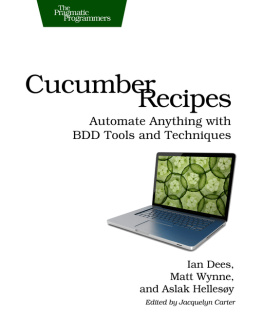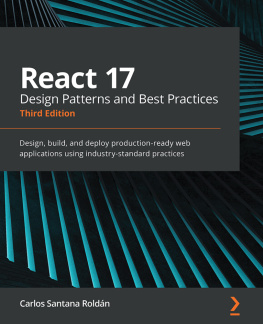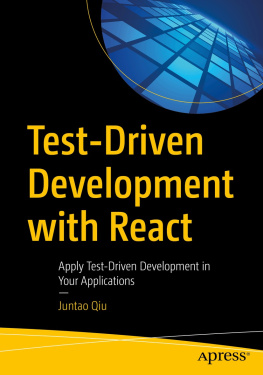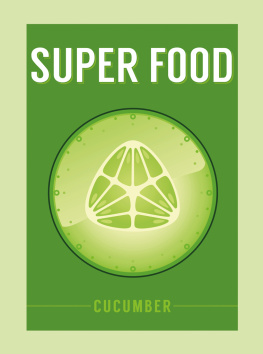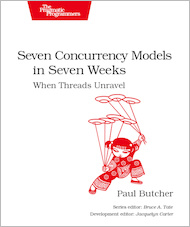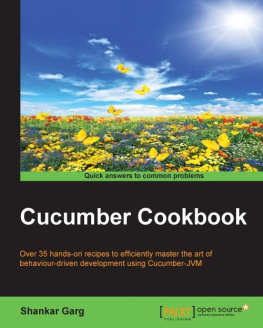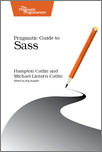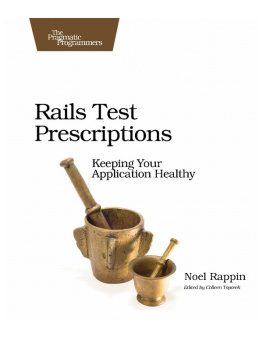Cucumber Recipes
Automate Anything with BDD Tools and Techniques
by Ian Dees, Matt Wynne, Aslak Hellesy
Version: P1.0 (February 2013)
Copyright 2013 The Pragmatic Programmers, LLC. This book is licensed tothe individual who purchased it. We don't copy-protect itbecause that would limit your ability to use it for yourown purposes. Please don't break this trustyou can use this across all of your devices but please do not share this copywith other members of your team, with friends, or via file sharing services. Thanks.
Dave & Andy.
Many of the designations used by manufacturers and sellers to distinguish their products are claimed as trademarks. Where those designations appear in this book, and The Pragmatic Programmers, LLC was aware of a trademark claim, the designations have been printed in initial capital letters or in all capitals. The Pragmatic Starter Kit, The Pragmatic Programmer, Pragmatic Programming, Pragmatic Bookshelf and the linking g device are trademarks of The Pragmatic Programmers, LLC.
Every precaution was taken in the preparation of this book. However, the publisher assumes no responsibility for errors or omissions, or for damages that may result from the use of information (including program listings) contained herein.
Our Pragmatic courses, workshops, and other products can help you and your team create better software and have more fun. For more information, as well as the latest Pragmatic titles, please visit us at http://pragprog.com.
Table of Contents
Copyright 2013, The Pragmatic Bookshelf.
Early Praise for Cucumber Recipes
With Cucumber Recipes you feel like the authors are right there with you, offering you advice, showing you hidden gems, or gently chastising you for things you know you shouldnt be doing. From general advice about taming unruly test suites or scaling out across multiple servers, to craziness like testing embedded Arduino hardware projects, they manage to cover an enormous amount of ground in a small space. Prepare for a fun and informative ride.
| Dan North |
| Originator of BDD and author of the RSpec story runner (Cucumbers predecessor) |
There are many cookbooks but very few chef books. Cucumber Recipes is inspiring enough to qualify as a chef book. If theres a will and a desire to use Cucumber in the process, Cucumber Recipes will more than likely show you a way...or many ways! From the basic to the esoteric, theres something for everyone in Cucumber Recipes .
| Michael Larsen |
| Senior quality assurance engineer, SocialText |
It is good to see that a free tool like Cucumber has been able to build up a community that treats BDD as its own child and carries it to nearly every possible platform and technology. This book provides a closer look at the details.
| Gspr Nagy |
| Developer coach at TechTalk, creator of SpecFlow |
If youre automating tests of any kind using Cucumber, in any language, against any type of software, you need this cookbook. Its recipes will help you write useful, easily maintained tests for even the most puzzling scenarios. Like all good cookbooks, it teaches good techniques and principles that will help you improve all your tests. Best of all, you can actually code the examples yourself, and learn by doing.
| Lisa Crispin |
| Co-author, Agile Testing: A Practical Guide for Testers and Agile Teams |
Cucumber Recipes has testing solutions for a variety of platforms. It is a powerful book that gives us useful tips to use BDD in our chosen environment. To realize the power of BDD, Cucumber Recipes is a must on every software test engineers table.
| Kavitha Naveen |
| Senior leadquality engineering |
Foreword
There was a time when one could analyze all that a program needed to do and then write the program that met that need. This stopped being a winning strategy when computers got big enough and fast enough to hold a description of the problem, not just the solution.
I embraced this change that went by the name of object-oriented programming . The advice was to divide large programs into parts that captured natural diversity. Then we were to program the parts to ask other parts for results without saying exactly how these results were to be achieved. This sounded simple. We no longer had to think everything through all of the time. Then, when we discovered one more case late in development, we were thankful we kept that complexity at a distance.
It was a good plan, but it turned out to be not quite that simple. Not only was there more than one way to chop up a program into parts, there was no easy way to tell which approach was going to prove to be leveraged when unforeseen needs surfaced, as they always do.
Agile
We forged ahead. We found dozens of techniques that helped keep track of what we had done, where we were going, and, especially, how to say yes, we can when asked to do something never once mentioned until our programs were used. When we say Agile today, were distinguishing ourselves from the days when we would resist change even if it meant finishing a program that wouldnt be used.
We asked our pioneers to experiment. We asked that they try new things and share with each other how they worked out. We asked our best developers to think about these new problems: where have we been, where are we going, and how will we know when we get there?
This book carries that tradition forward. Let me explain how.
Patterns
A program is a mathematical object that follows precise rules. This stops being important when we can no longer fully analyze our problems as we might a proof. Our progress toward Agile accelerated when we started cataloging solutions rather than deriving new ones from scratch each time they occurred.
A recurring pattern became an object of interest. A recurring problem in a context and a solution known to workthis is something worth sharing. When we started naming and documenting these patterns, we created a literature that had not yet existed. Practical problem solving was respected. Well-worn solutions were judged valuable...more valuable even than the most innovative ideas.
Although Cucumber offers a new and innovative way of pushing Agile forward, there is no reason for every Cucumber user to rediscover the contents of this book. The solutions come from many, for sure. But the simple existence of this catalog will raise our collective competence as we come to know of solutions whether we need them right now or not.
This book covers lots of ground. Some of it you will use immediately; other parts you will later. However, you will be served well to know the range of problems already solved.
Platforms
We appreciate how computers become more powerful each year. We hardly think of them as computers anymore. But they still need to be programmed. When we say Agile means yes, we can, we make a promise that becomes more difficult as capabilities proliferate. And each capability has its own constituents that want our attention.
Cucumber makes much of artifacts that can be shared across disciplines. A developer and a business analyst will bring different skills to a project. But if they are to coordinate their work, there must be some things they share. Cucumber meets that need.
This same distance from implementation allows Cucumber to straddle todays diverse implementation technologies. As our customers come to know many platforms, they expect us to know them too. As developers we begin to feel new pressure. Each platform has its quirks. That is where this book excels. As you are pressed into delivery on new platforms, you can bring Cucumber with you. But how do you hook it up? Read how here.

